Import
There are two options to import data:
There are two options to import data:
For a short introduction, see

In the menu, choose Data - 
 GFBio to open a window as shown below. Enter
the login data (User + Password) and the Key of the project.
To retrieve the data, click on the Connect
GFBio to open a window as shown below. Enter
the login data (User + Password) and the Key of the project.
To retrieve the data, click on the Connect  button. The software will retrieve the data provided for the project, as
shown below. Information concerning agents will be taken from the
selected DiversityAgents database, and the project selected within this
database. The GFBio portal does not enforce roles for all the agents
entered. If you want to add a role for agents where no role has been given
in the GFBio portal, you may choose a default.
button. The software will retrieve the data provided for the project, as
shown below. Information concerning agents will be taken from the
selected DiversityAgents database, and the project selected within this
database. The GFBio portal does not enforce roles for all the agents
entered. If you want to add a role for agents where no role has been given
in the GFBio portal, you may choose a default.

If you get an error message about missing identifier types, please open Administration - Identifier types… and insert the missing types.

If all needed types are available, click 
The import wizard is the general way to import data into a Diversity Workbench module database. It allows the import from tab separated text files (tsv) into the database tables. The key import steps, the definition of a mapping from tab seperated columns in the text file to the coresponding database table columns, is designed in the import wizard. As the mapping can be sometimes cumbersom to develop, the import wizard allows to save the mapping for repeated import of equaly structured tsv files.
The examples below are from the module 
With the current solution please ensure that there are no concurrent imports in the same database.
With this import routine, you can import data from text files (as
tab-separated lists) into the database. A short introduction is
provided in a video




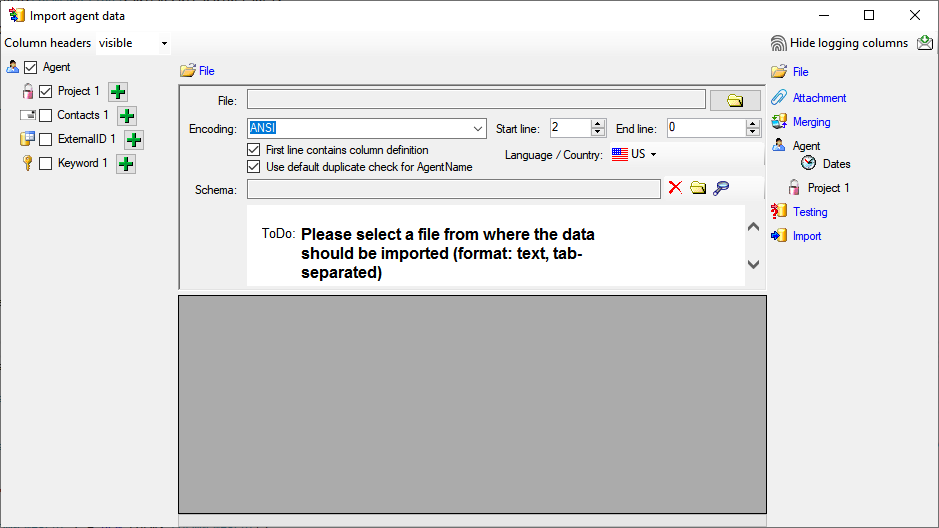
 File from where the data should be imported. The currently supported format is tab-separated text. Choosing a file will automatically set the default directory for the import files. To avoid setting this directory, deselect the option
File from where the data should be imported. The currently supported format is tab-separated text. Choosing a file will automatically set the default directory for the import files. To avoid setting this directory, deselect the option  Adapt default directory in the context menu of the button to open the file.
Adapt default directory in the context menu of the button to open the file.Starting with version 4.6 the default encoding changed to UTF8. Please use Windows for old ANSI encodings. The program will try to detect the encoding and warn you if it does not match the current encoding. The detection of the encoding depends on the presence of a BOM and does not work for every file, e.g. ANSI-encoding
 First line contains the column definition decides if this line will not be imported.
First line contains the column definition decides if this line will not be imported. Use the default duplicate check - see a video
Use the default duplicate check - see a video  for an explanation.
for an explanation. Translate \r\n to line break the character sequence \r\n in the data will be translated in a line break in the database.
Translate \r\n to line break the character sequence \r\n in the data will be translated in a line break in the database.
 Record all SQL statements.
Record all SQL statements. 

In the selection list on the left side of the window (see below) all possible import steps for the data are listed according to the type of data you want to import.
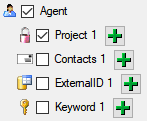
The import of certain tables can be paralleled. To add parallels click
on the 

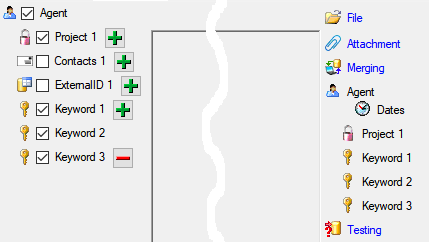
To import information of logging columns like who created and changed
the data, click on the  include logging columns button in the header line. This will include additional substeps for every step containing the
logging columns (see below). If you do not import these data, they will
be automatically filled by default values like the current time and
user.
include logging columns button in the header line. This will include additional substeps for every step containing the
logging columns (see below). If you do not import these data, they will
be automatically filled by default values like the current time and
user.

You can either import your data as new data or


Import as new data or one of the
columns the attachment columns offered like SeriesCode in the table
Series in the example below.

If you select a column for attachment, this column will be marked with a blue background (see below and chapter Table data).

You can either import your data as new data or  Merge them with data in the
database. Select the import step
Merge them with data in the
database. Select the import step  Merge from the list. For
every table you can choose between
Merge from the list. For
every table you can choose between 



The 
The 

The 

The 


Empty content will be ignored e.g. for the 

To set the source for the columns in the file, select the step of a
table listed underneath the  Merge step. All
columns available for importing data will be listed in the central part
of the window. In the example shown below, the first column is used to
attach the new data to data in the database.
Merge step. All
columns available for importing data will be listed in the central part
of the window. In the example shown below, the first column is used to
attach the new data to data in the database.

A reminder in the header line will show you which actions are still needed to import the data into the table:
 = No
column has been selected so far.
= No
column has been selected so far. = If data will be imported depends on the content of decisive
columns, so at least one must be selected.
= If data will be imported depends on the content of decisive
columns, so at least one must be selected. =
The position in the file must be given if the data for a column
should be taken from the file.
=
The position in the file must be given if the data for a column
should be taken from the file. = For all merge types other than insert columns
for comparison with data in the database are needed.
= For all merge types other than insert columns
for comparison with data in the database are needed. = You have
to select a value from the provided list
= You have
to select a value from the provided list = You have to enter
a value used for all datasets
= You have to enter
a value used for all datasetsThe handling of the columns in described in the chapter columns.
 - To test if all requirements for the import are met use the
- To test if all requirements for the import are met use the
 Testing step. You can use a certain line in
the file for your test and then click on the Test data in line: button. If there are still
unmet requirements, these will be listed in a window as shown below.
Testing step. You can use a certain line in
the file for your test and then click on the Test data in line: button. If there are still
unmet requirements, these will be listed in a window as shown below.
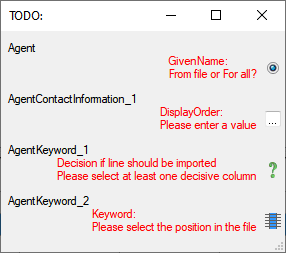
If finally all requirements are met, the testing function will try to write the data into the database and display any errors that occurred as shown below. All datasets marked with a red background, produced some error.

To see the list of all errors, double click in the error list window in the header line (see below).

If finally no errors are left, your data are ready for import. The colors in the table nodes in the tree indicate the handling of the datasets:
The colors of the table columns indicate whether a column is decisive



If you suspect, that the import file contains data already present in
the database, you may test this and extract only the missing lines in a
new file. Choose the attachment column (see chapter Attaching data) and
click on the button Check for already present data. The data already
present in the database will be marked red
(see below). Click on the button
Save missing data as text file 


If you happen to get a file with a content as shown below, you may have seleted the wrong encoding or the encoding is incompatible. Please try to save the original file as UTF8 and select this encoding for the import.
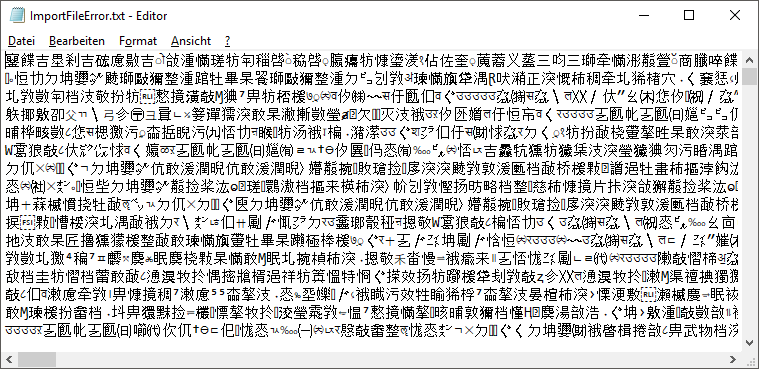


Schedule for import of tab-separated text files into DiversityAgents
Lines that could not be imported will be marked with a red background while imported lines are marked green (see below).
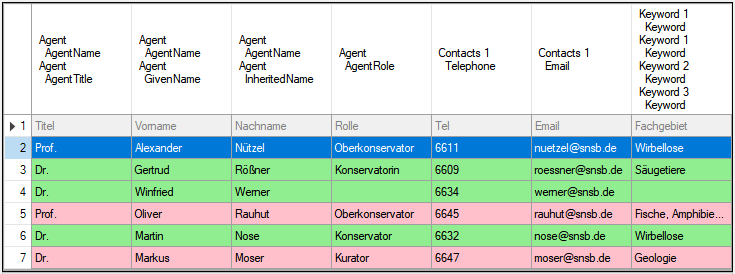
If you want to save lines that produce errors during the import in a separate file, use the Save failed lines option. The protocol of the import will contain all settings according to the used schema and an overview containing the number of inserted, updated, unchanged and failed lines (see below).
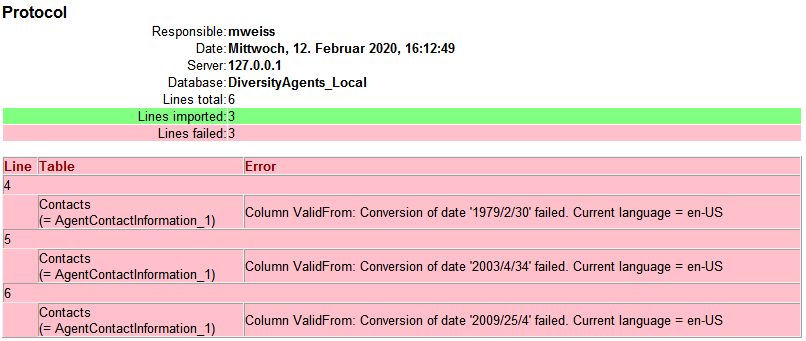



If the content of a file should be imported into a certain column of a
table, mark it with the 
The import depends on the data found in the file where certain columns
can be selected as decisive. Only those lines will be imported where
data are found in any of these
decisive columns. To mark a column as
decisive, click on the


In the example shown below, the file column Organims 2 was marked as decisive. Therefore only the two lines containing content in this column will be imported.

For the options 



The data imported into the database can either be taken
From file or the same value that you
enter into the window or select from a list can be used
For all datasets. If you choose the
From file option, a window as shown below will pop up. Just click in
the column where the data for the column should be taken from and click
OK (see below).
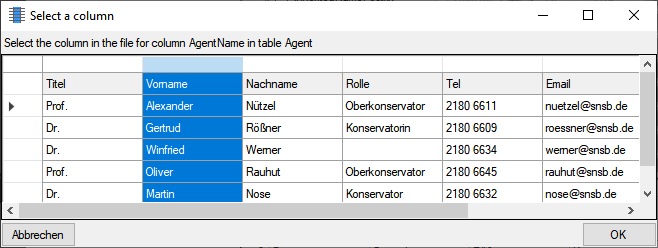
If you choose the For all option, you
can either enter text, select a value from a list or use a

The data imported may be 
If data in the source file are missing in subsequent lines as shown below,

you can use the 


In addition to the transformation of the values from the file, you may add a pre- and a postfix. These will be added after the transformation of the text. Double-click in the field to see or edit the content. The pre- and a postfix values will only be used, if the file contains data for the current position.
If for any reason, a column that should take its content from the
imported file misses the position of the file or you want to change the
position click on the 

The content of a column can be composed from the content of several
columns in the file. To 

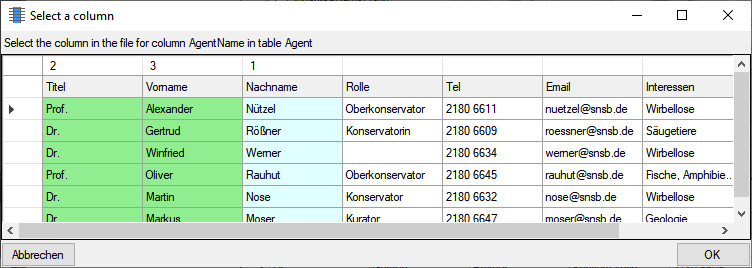
To remove an added column, use the 

The 
The data imported may be transformed e.g. to adapt them to a format
demanded by the database. A short introduction is provided in a video


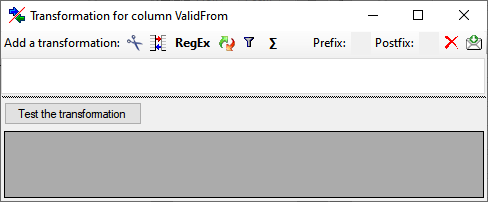
Here you can enter 4 types of transformation that should be applied to
your data. 



With the 


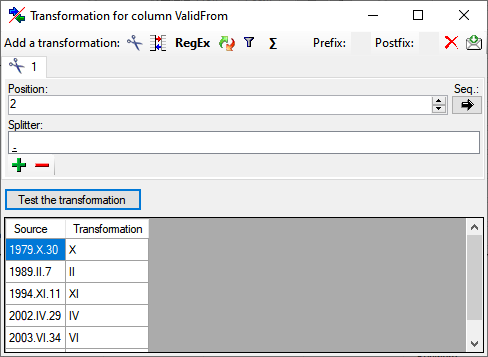
The 





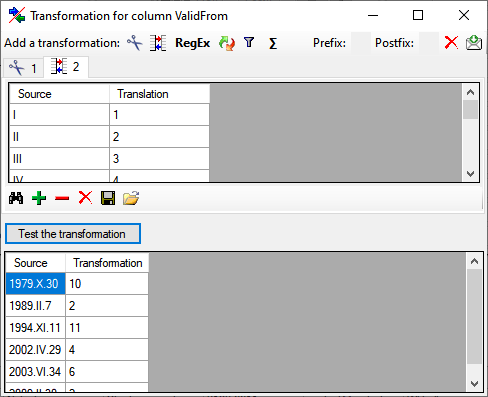
For columns with a lookup table as source, you can select the values from the source that will then be translated into e.g. the key of the source as shown in the example below
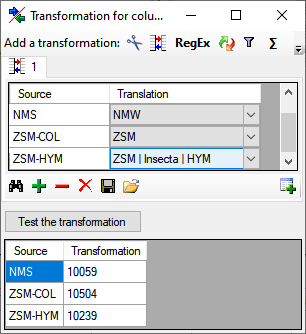
Use the 
To load a predefined list for the transformation use the



The RegEx transformation using regular expressions will transform the values according to the entered Regular expression and Replace by vales. For more details please see documentations about regular expressions.
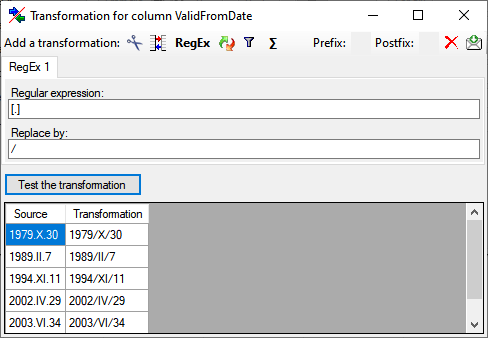
The 
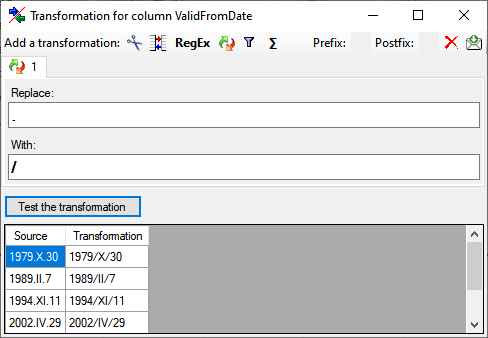
The Σ calculation transformation performs a calculation on numeric value, dependent on an optional condition. In the example below, 2 calculations were applied to convert 2-digit values into 4 digit years.

The 





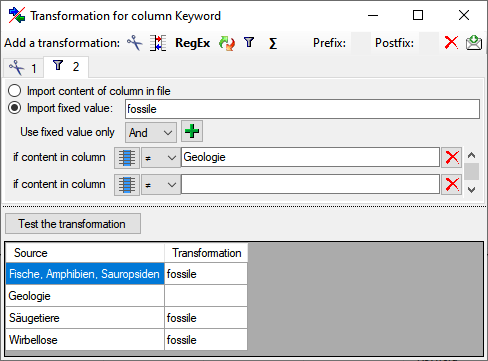
This tutorial demonstrates the import of a small file into the database. The following data should be imported (the example file is included in the software): At the end of this tutorial you will have imported several datasets and practiced most of the possibilities provided by the import wizard. The import is done in 2 steps to demonstrate the attachment functionality of the wizard.
Choose Data → Import → 


As a first step, choose the 

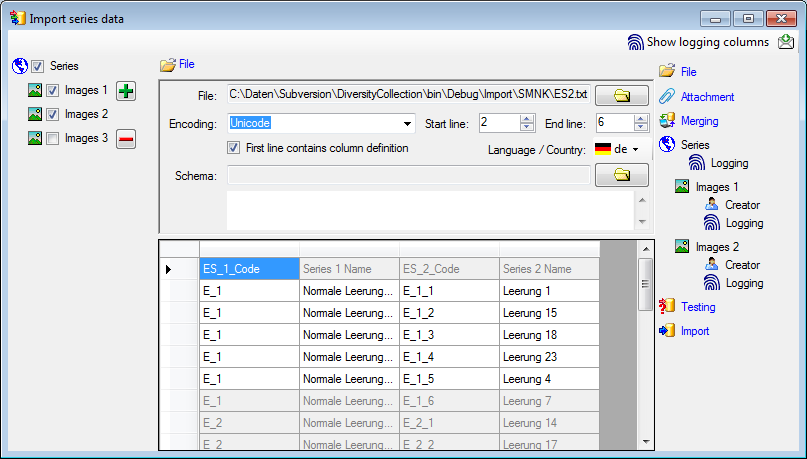
In the selection list on the left side of the window (see below) all possible import steps for the data are listed according to the type of data you want to import.

Certain tables can be imported in parallel. To add parallels click on
the 

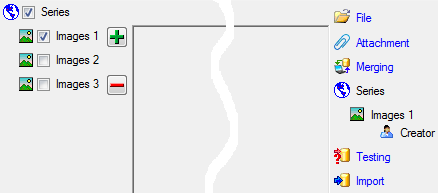
To import information of logging columns like who created and changed
the data, click on 
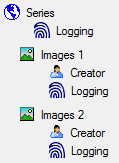
You can either import your data as new data or




If you select a column for attachment, this column will be marked with a blue backgroud (see below and chapter Table data).

You can either import your data as new data or 





The 
The 

The 

The 


To set the source for the columns in the file, select the step of a table listed underneath the Merge step. All columns available for importing data will be listed in the central part of the window. In the example shown below, the first column is used to attach the new data to data in the database.

A reminder in the header line will show you what actions are still needed to import the data into the table:
 = No
column has been selected so far.
= No
column has been selected so far. = If data will be imported depends on the content of decisive
colums, so at least one must be selected.
= If data will be imported depends on the content of decisive
colums, so at least one must be selected. =
The position in the file must be given if the data for a column
should be taken from the file.
=
The position in the file must be given if the data for a column
should be taken from the file. = For all merge types other than insert columns
for comparision with data in the database are needed.
= For all merge types other than insert columns
for comparision with data in the database are needed. = For every you
have to decide whether the data are taken from the file or a value
is entered for all
= For every you
have to decide whether the data are taken from the file or a value
is entered for all = You have
to select a value from the provided list
= You have
to select a value from the provided list = You have to enter
a value used for all datasets
= You have to enter
a value used for all datasetsThe handling of the columns in described in the chapter columns.
To test if all requirements for the import are met use the

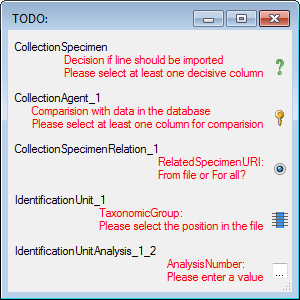
If finally all requirements are met, the testing function will try to write the data into the database and display you any errors that occurred as shown below. All datasets marked with a [red backgroud], produced some error.
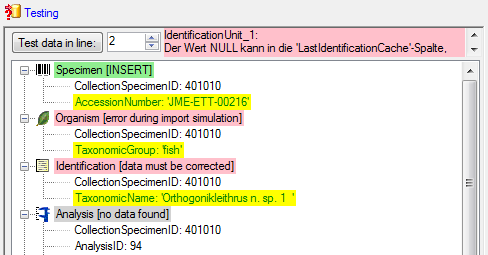
To see the list of all errors, double click in the [error list window] in the header line (see below).
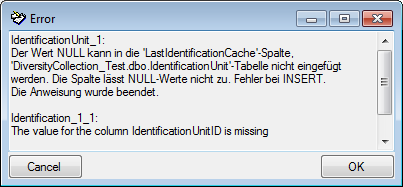
If finally no errors are left, your data are ready for import. The colors in the table nodes in the tree indicate the handling of the datasets: [INSERT], [MERGE], [UPDATE], [No difference]. [Attach], [No data]. The colors of the table colums indicate whether a colums is [decisive] , a [key column] or an [attachment column].
In case you get an error because you can not specify the

With the last step you can finally start to import the data into the database. If you want to repeat the import with the same settings and data of the same structure, you can save a schema of the current settings.
Lines that could not be imported will be marked with a red background while imported lines are marked green (see below).
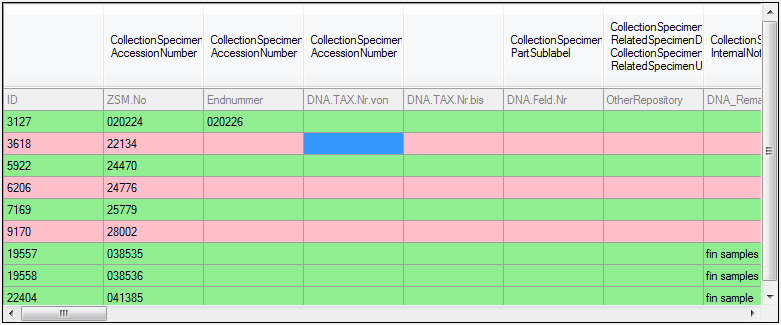
If you want to save lines that produce errors during the import in a separate file, use the Save failed lines option. The protocol of the import will contain all settings acording to the used schema and an overview containing the number of inserted, updated, unchanged and failed lines (see below).
